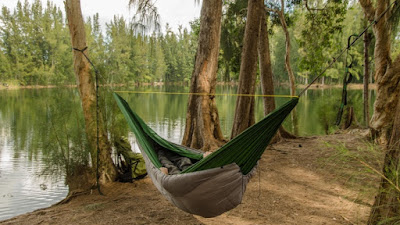
Though I tend to prefer hammocks for the "off the ground away from pests" and low footprint aspects. Having a good flat lay can be hard to achieve in a suspended hammock, and its nice to have company that isn't all pressed elbows and knees or bunk-stacked hammocks. For this reason I looked for a double bed style swag.
Kings Adventure was on my radar as source of gear, having seen them at Melbourne Camping and Caravan ShowMelbourne Camping and Caravan Show and having bought my camping stove from them having bought my camping stove from them . A happy medium between tent and bivy bag, a swag like this aa swag like this a self contained bed and shelter system.
Constructed from waterproof & Ripstop 400gsm canvas, with a heavy-duty waterproof 450gsm PVC bucket floor base. The two arc ends are supported by tent poles with clips, fitting to pegs held in split rings at each corner, have been upgraded to 10.2mm diameter for extra strength. The ends are held up by a telescoping alloy spreader pole, which also connects to polyester clips to lift the roof and keep the whole structure taut and self-standing. Corner pegs and end-flap guy lines help keep it secure and stable.
 Side flaps open all the way with heavy duty zippers on both sides, allowing easy access for either person ( as its a double) and bug-proof mesh with full zippers round out the build. Set up, the Swag is a spacious 2.15m (7') long and over 1.55m (5'1") wide, at the peak of its arc it is 96cm (3'1") high. Internally, both head and foot ends have a zippable window panel, behind more bug-mesh, and under storm flaps, allowing good airflow without compromising comfort. The real selling point for me, beyond the large footprint, was the included mattress. The ripstop fabric covered and free-floating pad is 7cm (2.75") thick, fully expanded. It's so comfortable.
Side flaps open all the way with heavy duty zippers on both sides, allowing easy access for either person ( as its a double) and bug-proof mesh with full zippers round out the build. Set up, the Swag is a spacious 2.15m (7') long and over 1.55m (5'1") wide, at the peak of its arc it is 96cm (3'1") high. Internally, both head and foot ends have a zippable window panel, behind more bug-mesh, and under storm flaps, allowing good airflow without compromising comfort. The real selling point for me, beyond the large footprint, was the included mattress. The ripstop fabric covered and free-floating pad is 7cm (2.75") thick, fully expanded. It's so comfortable.  Not only was it soft and padded, it also breathed and I could lay on it without matt or blanket without getting sweaty. The ceiling has loops for tying up the side flaps if they are up, but when down they serve as good tie-in points for a lamp or in my case to store my glasses whilst sleeping.
Not only was it soft and padded, it also breathed and I could lay on it without matt or blanket without getting sweaty. The ceiling has loops for tying up the side flaps if they are up, but when down they serve as good tie-in points for a lamp or in my case to store my glasses whilst sleeping. The heavy 400gsm canvas is weather proof and shady, allowing for afternoon naps as well as shelter from harsh sunlight as needs be.
Overall, I enjoyed sleeping in the Swag far more than I did in the Stratosphere Bivy, primary because of the mattress but also the roominess. Not having the skin of the Bivy pressing down on me made it a lot more comfortable. No shade on the bivy, but the more tent like Swag was a treat.
Tactical Baby and I camped out over a couple of nights and we did side-by-side camping, swapping after a night from bivy to Swag and we both agreed the swag was the more comfortable.
We hiked in to our site, and initially I had rolled the swag up in a single layer, so was a wide bundle at a little over 1.55m (5'1") wide, I carried it draped over a shoulder but I had rigged a sling to carry it at the small of my back on the way back which was more convenient but still wide.
 The swag only weighed 14kg, so its no trial to carry, even with the regular camping load, but once home I found I could double it over and roll it up to make a much more manageable bundle at 80 cm long x 50 cm across. This was possible with the built-in straps and double-D-shackle binders. The bundle was thus smaller and more manageable to transport and pack out and in the vehicle. It's obviously not as easy to ruck in as a bivy, but the luxury it brings is palpable and welcome, making up for the minor inconvenience . Better than hauling a full sized tent for sure. I haven't had opportunity to put it through a solid storm-test, but the construction seems solid and the stitching tight.
The swag only weighed 14kg, so its no trial to carry, even with the regular camping load, but once home I found I could double it over and roll it up to make a much more manageable bundle at 80 cm long x 50 cm across. This was possible with the built-in straps and double-D-shackle binders. The bundle was thus smaller and more manageable to transport and pack out and in the vehicle. It's obviously not as easy to ruck in as a bivy, but the luxury it brings is palpable and welcome, making up for the minor inconvenience . Better than hauling a full sized tent for sure. I haven't had opportunity to put it through a solid storm-test, but the construction seems solid and the stitching tight.



















































